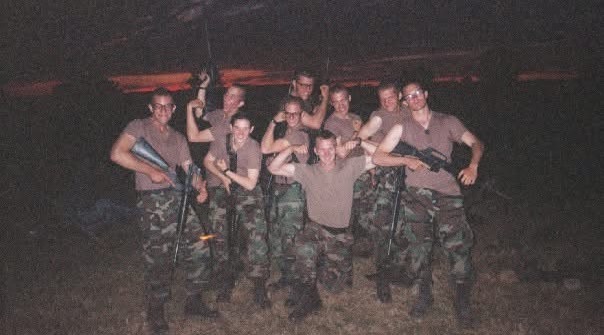This is the fourth essay in a five-part series. To read the previous piece, see here.
Rucking
The Army takes everything you loved as a child and makes it awful. Campgrounds turn into forward operating bases (FOBs). Reading for pleasure becomes memorizing to avoid pain. And hiking is transmogrified into its dirty, brutish cousin: rucking.
To properly ruck, one must first grab a shapeless burlap sack. The bulkier and less ergonomical, the better. Sew a pair of canvass straps onto it. Now stuff it to the brim with the heaviest objects you can find—stones, lead, platinum, uranium, if you can find it (you can, it’s in your compass, see “Cancer” section below). The point is not to pack items that might prove useful on your excursion (food, water, clothes, etc.), but to transform the rucksack into the most unpleasant and inconvenient object possible. Depending on the type and duration of the march, they could weigh anywhere between 40 and 70 pounds, though our combined equipment could sometimes close in on 100 pounds. Back and knee injuries were de rigueur, as were heat cats.
Throw on a Kevlar helmet, rifle, nine magazines, a gallon and a half of water, flak jacket, load bearing equipment (a utility belt with bullets and suspender straps), flip the rucksack onto your back while deviating as few discs as you can, and start marching. Any direction or terrain will do as long as it’s uphill.
If you must pee while marching and are lucky enough to possess a penis, simply spin around, undo your fly, whip it out, and urinate while walking backwards. If you don’t have a penis, as in most other situations, you’re shit out of luck. Have fun ducking into the bushes, popping a squat, and rushing to catch back up with the rest of your platoon. The march stops for no one. Until it does.
The most annoying part of rucking was maintaining intervals. We marched in two staggered lines on either side of the road, trying and often failing to keep 30 meters of space between ourselves and the next person diagonally across the street. The reasoning was that, should we be hit by indirect fire like mortars or grenades, no more than two of us would be killed at a time.
When implemented with hundreds of fresh-faced New Cadets, however, maintaining intervals was a nightmare. Inevitably, some guy at the front of the column would slow down and then jog to keep up the pace of march. This created an accordion effect so that, the farther down the line you got, the faster you had to move to catch up. The cadre would yell at us not to run, but if we didn’t run, we’d be left behind, which would result in more yelling. The poor suckers in the back of the formation could wind up standing stock still for minutes before sprinting a quarter mile for their lives just because someone at the head tightened their laces.
The Army Physical Fitness Test
Ah, the APFT. This exam measures every Army officer’s and enlisted person’s physical condition. We took it once a semester at West Point, not including our first exam during Beast.
I woke up, as usual, at butt-fuck o’clock in the morning, donned my PT uniform, and jogged in formation down a road that descended toward the Hudson River. Two soccer fields huddled on a small plane along its banks. I paired up with a squadmate to do the pushups and sit-ups that constituted the first portion of the test—one did the exercises while the other counted.
To correctly do an Army regulation pushup, your back must remain completely straight, your elbows must break 90 degrees, and you cannot place your knees on the floor at any time. I did about 60 in two minutes: a score of 85 out of 100. Next came the sit-ups. My partner held my ankles and ensured my shoulders passed over my hips on the way up and my back made full contact with the floor on the way down. I completed 111 in two minutes, blowing past the Army’s standard of 100 to get the maximum score—not bad.
The final test was a two-mile run along a one-mile course that paralleled the river before doubling back on itself. I ran track in high school and always had great endurance, so I wasn’t worried.
We started in a heat of 40 New Cadets. I settled into a long, comfortable stride and made my way toward the front of the pack. Piece of cake.
A quarter mile in, my stomach started to gurgle. That was weird. Whatever, just focus on your breathing, focus on the run—oh what the fuck! I turned my head just in time to eject a stream of vomit into the crisp morning air. The runners behind me cried in alarm as they avoided the spray.
Ugh, that was awful, maybe I got it out of my system—oh God!—out came another stream of vomit. But I kept up my pace, not slowing for an instant. By the time I rounded the orange cone set at the far end of the course, I’d thrown up three more times. I checked my watch. Still making good time.
And so it went throughout the remaining mile. I’d feel a rumble in my stomach, my entire upper body contracted in painful spasms, and up came whatever I had for dinner the night before, further ensuring I wouldn’t get my daily allotment of calories.
When I finally crossed the finish line, I’d vomited a total of 11 times, to the horror of everyone behind me. Nevertheless, I somehow managed to complete the course in 13:30, a score of 93 out of 100 and the best time I managed at West Point. The craziest part of the story is that I’ve been an endurance runner for 25 years, clocking thousands of miles, and not once before or since have I ever thrown up during a run.
Breakdancing
At some point during Beast, the cadre learned I could breakdance. This tickled them pink so, whenever we had a second of downtime, someone would inevitably yell, “New Cadet Otazo! Breakdance!” I did as ordered and started with a two-step, dropped to the ground into a corkscrew, transitioned to a windmill, and ended on a freeze before flipping to my feet.
They freaking loved it. I b-boyed in the dining hall, in briefing rooms, in the barracks hallway, at the rifle range, in formation, on the parade ground, in the middle of the forest, literally any and everywhere. I broke in front of generals and the 82nd Airborne non-commissioned officers who trained us. But I wasn’t the only one whose esoteric talents were utilized to entertain.
One New Cadet with an incredible voice was routinely placed on the wall to sing “Part of Your World” from the Little Mermaid soundtrack. Another who had a gift for imitating voices was made to constantly tally objects in the vein of the Count from Sesame Street. I’d hear his voice booming across the dining hall crying “Sergeant! There is one apple on the table! Ha! Ha! Ha! Two Apples on the table! Ha! Ha! Ha!” and so on.
For my part, I didn’t mind dancing. It reminded me of my civilian life and the cadre were less likely to haze me if I made them laugh.
Sergeant Michael Deforest
Cadet Sergeant Michael Deforest from the tiny town of Albany, Kentucky was and continues to be a badass. His classmates called him Iron Mike, and for good reason. The man was a PT monster. He routinely maxed out the APFT. He could bend the laws of biology and physics to his will, running faster, doing more pushups, rucking longer with more weight than just about anyone short of Superman. He was my second Beast squad leader.
After the first three weeks of Beast concluded, there was a complete turnover in our cadre. Everyone from the company commander down to the squad leaders was replaced by a new batch of Cadets. We were understandably worried because, though our first squad leader hazed us constantly, we were accustomed to his moods and triggers. We knew what would set him off and how to generally keep him appeased. That all went out the window at the beginning of the new term, also known as Beast 2.
Sergeant Deforest walked into the barracks, lined us up on the wall, and beamed.
“You know who the Spartans were?” he asked.
We eyed each other nervously.
“They were the greatest fighting force in ancient Greece,” he explained. “From now on, we are the Spartans. We’re going to be the best squad in the entire Corps.”
He took charge of a random collection of New Cadets, told us we were the most elite unit in Beast, and made us believe him—nothing short of a miracle.
Sergeant Deforest did incredible things. He got down with us to do every single pushup. He didn’t lose his temper. He wasn’t cruel. He didn’t haze, he corrected. He wanted us to be better and made us want to be better for him and each other. He let us laugh and bond as a squad. When we struggled, he was always by our side with a word of encouragement, a reminder that all difficult things end and we would grow stronger for doing them.
He was one of the greatest leaders I ever met. He led from the front, shouldering the heaviest burden without complaint because a job needed to be done. He is the standard by which I hold my leadership and everyone else’s. I often think about him when speaking to students about my work in the mangroves.
At the end of three weeks, he won the Squad Leader of the Term Award—the absolute best of Beast 2, and he deserved it.
Cancer
A classic Army joke goes that everything the service issues you causes cancer. There’s more than a little truth to this. Contracts to make our gear were awarded by congressional mandate to the lowest bidder. The mosquito repellent was basically 1,000% DEET. God knows what went into MREs to preserve them for half a decade. Fire retardant suits used to be made of asbestos. Even the sunscreen smelled like a chemical fire.
Sometimes, contractors got creative. The United States has an enormous surplus of depleted uranium from its many nuclear reactors. Eventually, someone discovered that the heaviest naturally occurring element had amazing self-sharpening properties. So, they started arming the tips of sabot rounds fired out of M1 Abrams tanks with the stuff. Great for penetrating composite armor, terrible for T-72 tankers, and also not great for friendly crews handling the stuff in airtight metal boxes or civilians who tried to rebuild on old armor battlefields.
Nevertheless, America wasn’t firing off enough sabot rounds to make a meaningful dent in the depleted uranium stockpile. But guess what else it’s great at. Glowing in the dark! For millennia! And that’s why the Army put beads of the super-heavy element in our compasses: so we could always tell which way was north, even in the darkest nights. The only tradeoff being that we had to constantly wear radioactive devices on our hips.
Sex & Gender
West Point was definitely harder for women. The flak vests weren’t designed for breasts, the rucksacks weren’t designed for female hips, and the entire institution wasn’t designed for anyone but men, therefore forcing women to contort themselves into man-shaped molds to have any chance of acceptance. Not that doing so appeased the sizable number of their male colleagues and superiors who would’ve loved to drop the proportion of West Point’s female population from 14% to zero.
Many male Cadets resented that their female classmate didn’t need to do as many pushups or sit-ups or run as fast for the APFT. Beyond physicality, they painted female Cadets as mentally weak, emotionally unstable, and more likely to crack in combat. They ridiculed their supposed lack of femininity in uniforms designed for men by calling them the derogatory term “trou” (short for “trousers,” which ostensibly made them look masculine).
The female cadre sometimes treated female New Cadets worse than their male counterparts. This internalized misogyny was rationalized by the cadre’s desire to weed out weak women who didn’t belong, who might make their entire gender look bad in front of the male upperclassmen, officers, and instructors, and might therefore make their own lives more difficult.
If anything, women at West Point kept their heads better than men. They had far more developed risk assessment abilities, thereby ensuring they were less likely to do something stupid like fall down the side of a mountain. Some were physical beasts, able to ruck, march, fight, shoot, lift, and run with the best of the men. I’m not remotely ashamed to write that a female Cadet choked me out during a sparring match because she was better than me.
There were all sorts of rumors during Beast about female New Cadets having sex with their classmates in closets, bathrooms, or the woods. I have a sneaking suspicion this was more about slut shaming than objective reporting. I certainly didn’t have any sex during those two months. I don’t know anyone else who had sex. And I didn’t catch anyone having sex.
West Point tried its damnedest to make campus the most sexless place in America. If Cadets of the opposite gender were in a room together, the door needed to be propped open at 90 degrees. Men and women couldn’t sit on the same flat surface together, including couches, tables, desks, or even the floor. It goes without saying that any form of PDA including holding hands was strictly forbidden while in uniform.
That’s not to say sex didn’t happen. West Point was packed to the gills with some of the country’s most intelligent, muscular, stressed out, frustrated guys taking communal showers together. Get the fuck out of here. The dudes definitely fucked. So did the girls. My sophomore year girlfriend’s (yes, I eventually got a girlfriend; she was a year older and outranked me and it was hot) lesbian roommates banged it out every night. But this was the high-water mark of Don’t Ask Don’t, so we ignored the flagrant homoeroticism everywhere and just called it bros having fun.
Another thing that absolutely happened was masturbation. Regulations be damned, we were still 18-year-old kids. When guys and gals wanted time alone with their thoughts, they put a white glove on the doorknob to avoid being disturbed. Sometimes they didn’t even bother doing that and shamelessly went to town with a roommate in the adjacent bed or desk. People jerked it in bathroom stalls, in bushes, in Port-a-Johns, in their tents, anywhere and everywhere they thought they wouldn’t get caught or didn’t care if they did.
Guns
Every room in the barracks came stocked with two M-14 rifles. This Vietnam era weapon’s wood and steel construction made it great for engaging the enemy at long range. Clocking in at 10 pounds with bayonet attached, it was a heavy gun, which all Cadets knew intimately because it was the rifle we used to parade. Don’t worry, though, the brass had sufficient foresight to remove the charging pins so strung-out Cadets wouldn’t be tempted to find a loose 7.62 round and blow their brains out.
When in the field, we were issued M-16 rifles, a larger version of the M-4 carbine that is standard throughout the U.S. military today. We used magazines stocked with blank rounds for most of our exercises—only switching to live rounds on the range. All that firing meant the temperamental rifles would constantly jam. So, we had to spend hours disassembling and cleaning them. The downside was that this made it very easy to lose pieces, especially in the field.
The one piece you didn’t want to lose was the charging pin. Without this tiny metal fork the length of a fingernail, the rifle would not shoot. Period. And nothing made a crusty Master Sergeant happier than hearing the tell-tale click of a New Cadet’s rifle missing its charging pin. He’d gleefully saunter into the woods, waddle back carrying a 30-pound rock, hand it to the New Cadet, and declare, “This is your new charging pin!” The poor guy would then have to lug the stone around in his rucksack for the rest of Beast.
We went everywhere with our rifles. We ate meals with them, did PT with them, slept with them, and even gave them names (mine was Ashley). If we let them out of our sight for a second, the cadre was more than liable to steal them, and then we’d be in real shit for losing a key piece of combat equipment. They’d even sneak into our tents or creep up to us on our sleeping mats. That’s why I always threaded my belt through my rifle strap before laying down in the field.
The House of Tears
Everyone who graduated Beast remembers the House of Tears. Not that it made the strongest first impression. This nondescript single story concrete building was about the length and width of a middle-class living room. What made it memorable was what happened within.
Part of our training involved chemical and biological warfare. To protect against these threats, soldiers don Mission Oriented Protective Posture (MOPP) equipment in the form of a rubber suit, gas mask, and hood that covers them from head to toe. Unsurprisingly, the equipment is hellishly hot, especially when worn on a New York summer afternoon. Quick aside, if the U.S. Army ever finds itself fighting in full MOPP gear—clouds of chlorine and VX gas wafting across the battlefield—the planet has truly and irrevocably gone tits up.
My squad lined up nervously in our MOPP gear outside the House of Tears. A side door opened, a swirl of gray smoke billowed out, and we walked into the dark interior. Our 82nd Airborne trainers had set off several concentrated salt (CS) grenades inside the building. This is better known as riot control gas, and it was designed to disburse large crowds in open areas. Whenever you see protestors crying and gagging in the street, this is what they were exposed to. In our case, we walked into a 10-by-10-foot room packed with the stuff.
Inside, I could barely see three feet in front of me through the world’s most infernal fog. We checked our seals, but I could already feel the skin between my hood and mask start to burn. We did pushups, jumping jacks, and flutter kicks. Then it was showtime. Opposite the entrance door was an exit, and in front of that exit was a burly 82nd Airborne soldier also in MOPP gear.
I walked up to him, pulled off my hood, took off my mask, and regretted a lifetime of decisions that brought me to that point. CS gas does some funny things to the human body. Any exposed skin burns. It causes all the bodily fluids in your head to come rushing out at once. You also desperately want to vomit but can’t take a deep enough breath to do so because it feels like a bodybuilder jammed their arm down your throat.
My ticket out of there was to tell the 82nd Airborne guy my first and last name, city and state of birth, social security number, and “Airborne, Airborne all the way. Airborne, Airborne every day.” Not “Airborne, Airborne every day. Airborne, Airborne all the way,” mind you. No, even the slightest derivation from the exact phrasing and order would mean I had to start over.
I coughed and sputtered the required phrases two times before I was mercifully let out, and I got off easy. Some New Cadets struggled through them half a dozen or more times. A few lost their nerve, somehow sidestepped the soldier, and ran out. They were dutifully collected and made to go again.
Outside, the cadre laughed when we emerged, gasping, crying, and flapping our arms like fledgling pigeons. We were told this helped dissipate the gas, but it was just another thing they made us do because they thought it was funny. I was, however, warned to avoid an infamous tree by the exit which many New Cadets sprinted headlong into as they escaped.
. . . . .
This is the fourth of a five-part series of essays recounting my experience during West Point’s Cadet Basic Training. The final article will be published next week.
If you like our stories, check out The Miami Creation Myth hardcover.




